Basins and ranges
Some areas, such as the Basin and Range Province of the western United States (Utah, Nevada, and California), contain an extensive network of relatively small tectonic depressions closely akin to rift valleys. The topography consists of basins 10 to 30 kilometres wide and 50 to 200 kilometres long, separated by ranges of similar dimensions. The basins contain young sediment derived from the neighbouring ranges and are quite flat. The sides of the basins can be steep or gentle. Where a major fault separates a basin from a range, the edge of the basin is often steep. Where the edge of the basin is produced by the tilting of the basin down and of the range up, the flank is gentle, with average slopes of from a few to 15°. These tilted, gently dipping slopes are particularly apparent wherever lavas, resistant to erosion in dry climates, had flowed onto the surfaces before they were tilted. Such tilted lava-capped surfaces are known as louderbacks. In sum, the tectonic basins of the Basin and Range Province are similar to rift valleys, but their dimensions are smaller, and the ranges are tilted blocks or horsts.
Networks of basins and ranges exist in several other high plateaus. Northerly trending basins lace the Tibetan Plateau; however, unlike those of the western United States, they are more widely spaced, occurring hundreds of kilometres apart. Moreover, a single northerly trending range in Tibet does not in general separate neighbouring basins from one another. The development of a basin and range morphology in Tibet is at a much earlier geologic stage than that of the western United States. The landscape of western Turkey likewise is cut by easterly trending basins and neighbouring ranges that were formed by crustal extension in its north–south dimension. This morphology of basins and ranges extends westward beneath the Aegean Sea. Many of the islands in the Aegean are ranges between basins that stand high enough to poke above sea level. Thus, whereas the dominant feature in a rift valley is the deep wide valley itself, the ranges and valleys are of comparable importance in basin and range topography.
Pull-apart basins
Some tectonic valleys are rectangular or rhomb-shaped basins, bounded by as many as four steep sides. The Dead Sea, the lowest place on Earth, lies 396 metres below sea level at the bottom of just such a basin. Another is the Imperial Valley of southern California, most of which also lies below sea level. These tectonic valleys are closely related to major strike-slip faults—nearly vertical faults along which material on one side moves horizontally with respect to that on the other.
In regions such as the Dead Sea or southern California, nearly parallel strike-slip faults bound two sides of the tectonic valley and end at the valley. Slip on the overlapping segments of the strike-slip faults results in crustal extension in the region between the two faults. Thus two sides of the tectonic valley are bounded by faults with primarily horizontal displacement, and the other two sides are bounded by faults with vertical components of slip. These basins are called pull-apart basins because the crust is literally pulled apart in the section between the two strike-slip faults.
Ramp valleys
As previously noted, these depressions are similar to rift valleys, but they have been formed by the opposite process—crustal shortening. A ramp valley develops when blocks of crust are thrust toward one another and up onto an intervening crustal block. The latter is forced down by the weight of this material, resulting in the formation of the valley. The thrusting of the material onto the intervening crustal block creates high mountains adjacent to the valley.
Ramp valleys are characterized by steep sides tens of kilometres apart, and flat floors, which contain debris eroded from the neighbouring mountains. Escarpments on the edges of ramp valleys are not as sharply defined as for simple rift valleys, but the surrounding mountains can be higher than those that bound the latter. To a casual observer, the landscapes of ramp and rift valleys are very similar. In fact, early theories for rift valleys incorrectly attributed their origin to that of ramp valleys.
The most spectacular example of a ramp valley is the Turfan Depression, the second lowest place on Earth (154 metres below sea level), which lies within the Tien Shan of western China and along the northern margin of the Gobi. In general, the rapid filling of ramp valleys in all but the most arid climates makes them ephemeral features; however, small, young ramp valleys can be found in the South Island of New Zealand east of the Southern Alps, and remnants of ramp valleys lie within the Rocky Mountains of the western United States.
Foreland basins
These lie in front of major mountain ranges—e.g., south of the Himalayas, north of the Alps, and east of the Canadian Rocky Mountains. Most basins of this kind are subsurface features, filled with sediment eroded from the adjacent mountain ranges; thus, they are not easily recognized in the flat landscape that is visible. Foreland basins are formed because the overthrusting of the mountains onto a neighbouring lithospheric plate places a heavy load on the plate and flexes it down, much as a diving board is flexed down by the weight of the diver. Foreland basins are deepest and young sediments are thickest next to the mountain range, and the thickness of material decreases gradually and smoothly away from the mountains. The rapid deposition of sediment from the mountains makes a nearly flat surface, such as the Indo-Gangetic Plain of northern Pakistan and India where the Indus and Ganges rivers flow south of the Himalayas. Foreland basins can be important sites of oil and gas reserves.
Peter H. Molnar




